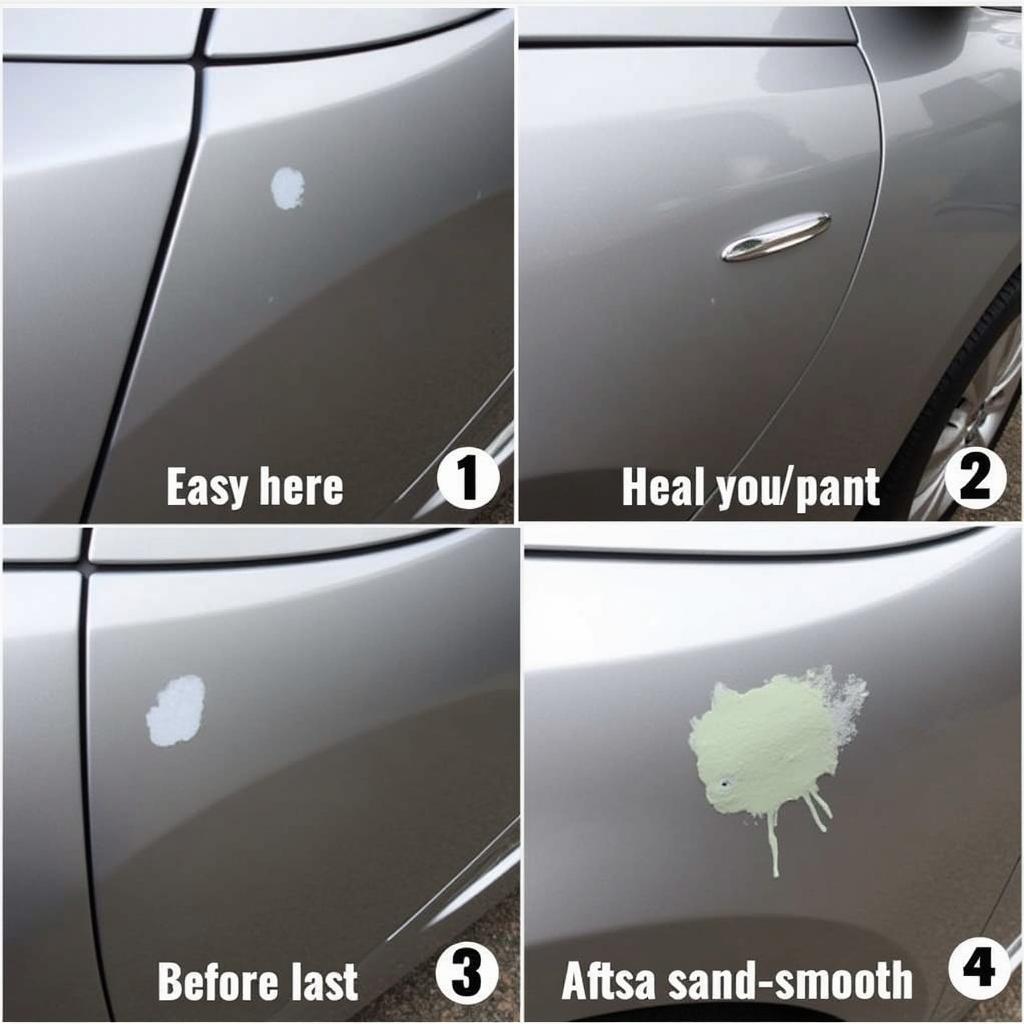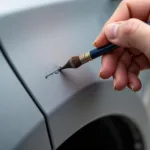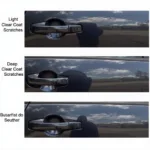Knowing how to repair paint damage on your car can save you a significant amount of money and keep your vehicle looking its best. Whether it’s a minor scratch, a deep chip, or sun-damaged clear coat, understanding the right repair techniques can make a world of difference. This comprehensive guide will equip you with the knowledge and practical steps needed to tackle various car paint damage scenarios.
Identifying the Type of Car Paint Damage
The first step in repairing paint damage is to accurately identify the extent of the problem. Is it a light scratch that only affects the clear coat? Or is it a deeper gouge that has reached the primer or even the bare metal? Correctly assessing the damage will determine the appropriate repair method. Minor scratches can often be addressed with DIY solutions, while more severe damage may require professional intervention.
DIY Paint Damage Repair for Minor Scratches
For light scratches and swirl marks, you can often achieve satisfactory results using a rubbing compound or a scratch remover. how to repair paint damage on car bumper provides valuable insights into dealing with bumper scratches. Apply the compound to a clean, soft cloth and gently rub it onto the affected area using circular motions. This process helps to level out the clear coat and minimize the appearance of the scratches. Follow up with a polishing compound to restore the shine.
What Causes Swirl Marks?
Swirl marks are often caused by improper washing techniques, such as using a dirty sponge or wiping the car with a dry cloth. They can also result from automatic car washes that utilize harsh brushes.
Repairing Deeper Paint Chips and Scratches
Deeper scratches and chips that penetrate the color coat require a more involved approach. You’ll need to clean the area thoroughly, remove any loose paint or rust, and then apply touch-up paint. spot repair car paint offers a detailed guide on spot repairing paint chips. For deeper chips, you might need to apply several thin coats, allowing each coat to dry completely before applying the next. After the touch-up paint has dried, you can carefully sand the area to blend it with the surrounding paint and then apply clear coat to protect the repair.
 Deep Paint Chip Repair Process
Deep Paint Chip Repair Process
How to Choose the Right Touch-Up Paint?
Finding the exact color match for your car’s paint is crucial for a seamless repair. Check your owner’s manual or the vehicle identification plate for the paint code.
Addressing Sun Damage and Faded Paint
Prolonged exposure to the sun can cause car paint to fade, oxidize, and lose its gloss. repair sun damaged paint on cars discusses effective methods to rejuvenate sun-damaged paint. This might involve using a specialized compound designed to remove oxidation, followed by polishing and waxing to restore shine and protect the paint. In some cases, a complete repaint may be necessary for severely sun-damaged vehicles.
When to Seek Professional Help
While many minor paint repairs can be handled at home, there are instances where professional help is recommended. For extensive damage, such as large dents or deep scratches that expose the metal underneath, it’s best to consult a qualified auto body repair shop. They have the expertise and equipment to perform more complex repairs and ensure a flawless finish. car paint damage repair cost gives you an idea of potential costs involved. Bird droppings can also damage car paint; you can learn more about this in how to repair bird poop damage car paint.
Conclusion
Learning how to repair paint damage on car can empower you to maintain your vehicle’s appearance and potentially save on expensive repairs. By understanding the different types of damage and the appropriate repair methods, you can address minor imperfections yourself and make informed decisions about when professional help is required. Remember to always prioritize safety and use the proper tools and materials for the best results.
FAQ
- Can I use nail polish to repair a paint chip?
- How long does touch-up paint take to dry?
- What is the difference between rubbing compound and polishing compound?
- Can I wax my car after repairing a scratch?
- How can I prevent future paint damage?
- Is it necessary to use a primer when repairing deep scratches?
- What are the signs of clear coat failure?
Common Car Paint Damage Scenarios
- Scratches from car washes: These are often superficial and can be addressed with rubbing compound.
- Stone chips: These require touch-up paint and possibly clear coat.
- Scuffs from parking lot bumps: Depending on the severity, these might need touch-up paint or professional repair.
- Fading and oxidation from sun exposure: This can be addressed with specialized compounds or a full repaint.
Related Articles
Check out these other helpful articles on our website:
- How to Detail Your Car at Home
- Choosing the Right Car Wax for Your Vehicle
- Protecting Your Car Paint in Winter
Need more help? Contact us via WhatsApp: +1(641)206-8880, Email: [email protected]. We have a 24/7 customer support team.


